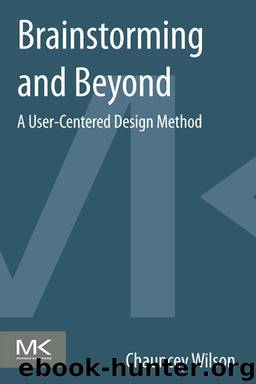Brainstorming and Beyond by Chauncey Wilson

Author:Chauncey Wilson
Language: eng
Format: epub
ISBN: 9780124071667
Publisher: Elsevier Inc.
Published: 2013-01-23T16:00:00+00:00
Figure 1.1 Ungrouped data before an affinity diagramming session and named groups after a session.
The affinity diagramming method originated with the software quality movement that began in Japan (Babbar, Behara, & White, 2002). The original intent of the affinity diagramming was to help diagnose complex problems by organizing data from various sources to reveal themes related to the problem. The basic affinity diagramming method involves:
1. Gathering qualitative data from multiple stakeholders. This data can be text or images or work artifacts.
2. Writing units of data on “sticky notes,” note cards, or even magnetic “paper”.
3. Placing the items on a large surface.
4. Asking the participants to organize the items into “affinity groups”—groups of items that “go together” or that are related in some way (Figure 1.1).
5. Breaking large groups of notes into smaller subgroups.
6. Asking the participants to generate names (often called “labels”) for the affinity groups and subgroups.
7. “Walking the diagram” as a group to ensure that everyone is clear on the meaning of the items and names for the groups.
8. Drawing the diagram formed by the groups and subgroups. The part of the process is used to clearly show the relationships between groups.
9. Prioritizing the items for further consideration in the design of products or processes.
Download
This site does not store any files on its server. We only index and link to content provided by other sites. Please contact the content providers to delete copyright contents if any and email us, we'll remove relevant links or contents immediately.
Hello! Python by Anthony Briggs(10116)
The Mikado Method by Ola Ellnestam Daniel Brolund(10005)
Dependency Injection in .NET by Mark Seemann(9511)
Sass and Compass in Action by Wynn Netherland Nathan Weizenbaum Chris Eppstein Brandon Mathis(7909)
Svelte with Test-Driven Development by Daniel Irvine(7766)
The Well-Grounded Java Developer by Benjamin J. Evans Martijn Verburg(7764)
Test-Driven Development with PHP 8 by Rainier Sarabia(7492)
Layered Design for Ruby on Rails Applications by Dementyev Vladimir;(7332)
Web Development with Django by Ben Shaw Saurabh Badhwar(6834)
Secrets of the JavaScript Ninja by John Resig Bear Bibeault(6628)
Secrets of the JavaScript Ninja by John Resig & Bear Bibeault(6627)
React Application Architecture for Production by Alan Alickovic(6524)
Jquery UI in Action : Master the concepts Of Jquery UI: A Step By Step Approach by ANMOL GOYAL(5865)
Kotlin in Action by Dmitry Jemerov(5291)
Software Architecture for Web Developers by Mihaela Roxana Ghidersa(4770)
Audition by Ryu Murakami(4760)
Accelerating Server-Side Development with Fastify by Manuel Spigolon Maksim Sinik & Matteo Collina(4614)
Hands-On Full-Stack Web Development with GraphQL and React by Sebastian Grebe(4378)
Solidity Programming Essentials by Ritesh Modi(4339)
